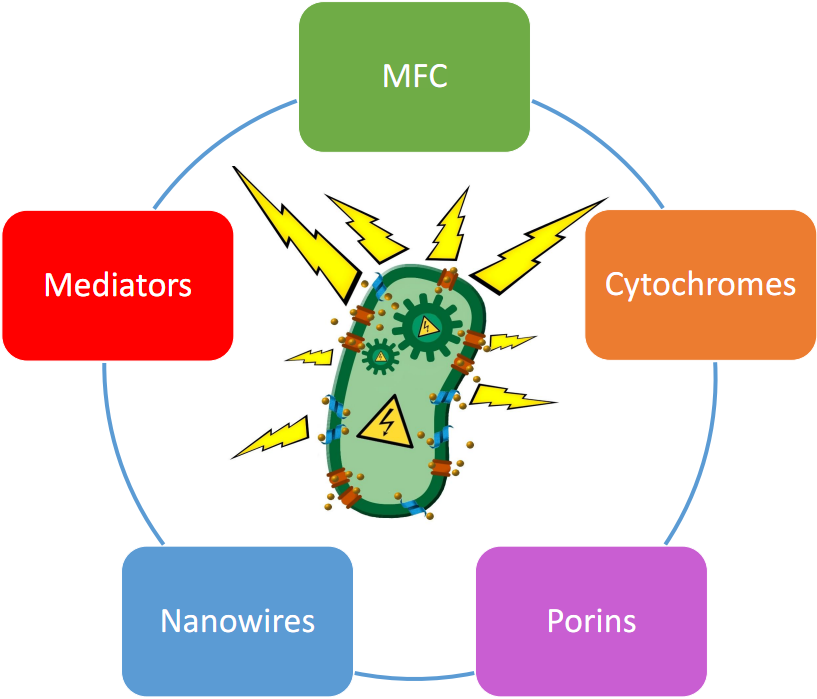Team:Bielefeld-Germany/Project/Abstract
From 2013.igem.org
| Line 105: | Line 105: | ||
| - | *<p align="justify">Mediators are essential for the use of ''Escherichia coli'' in Microbial Fuel Cells. The main advantage of improving MFCs is to enhance kinetics of the electron transfer between the bacterial cells and the fuel cell anode. Enhancing the mediator concentration in the MFC is an efficient way for higher electron transfer. In order to decrease the usage of expensive and toxic synthetic mediators, we engineered an ''E. coli'' KRX strain with overexpression of glycerol dehydrogenase (GldA). GldA produces the endogenous mediator NADH from NAD<sup>+</sup> and glycerol, which is the main carbon source of our medium. Optimized ''E. coli'' produces efficient mediators. [[Team:Bielefeld-Germany/Project/ | + | *<p align="justify">Mediators are essential for the use of ''Escherichia coli'' in Microbial Fuel Cells. The main advantage of improving MFCs is to enhance kinetics of the electron transfer between the bacterial cells and the fuel cell anode. Enhancing the mediator concentration in the MFC is an efficient way for higher electron transfer. In order to decrease the usage of expensive and toxic synthetic mediators, we engineered an ''E. coli'' KRX strain with overexpression of glycerol dehydrogenase (GldA). GldA produces the endogenous mediator NADH from NAD<sup>+</sup> and glycerol, which is the main carbon source of our medium. Optimized ''E. coli'' produces efficient mediators. [[Team:Bielefeld-Germany/Project/GldA|Read more]] about our subproject GldA, of the theory behind, the genetic approach, to the results.</p> |
Revision as of 09:36, 3 October 2013
Project
Abstract
There is a growing interest in the use of alternative energy sources. Decreasing use of fossil fuels in the context of atmospheric greenhouse gas reduction, coupled with the recent reduction of nuclear power production in Germany have encouraged the search for alternative energy production processes. Generation of electricity at large scales can have negative impacts on local environments and the use of energy storage devices on a small scale holds the risk of release of toxic pollutants from batteries. In consideration of these issues, the iGEM team of Bielefeld University is undertaking a project called "Microbial fuel cell" (MFC) this year. The goal of this project is to use bacteria for direct energy production from organic substrates. Unlike conventional batteries, a Biobattery is environmentally friendly and easy to “charge” through substrate refilling. Due to its simple design, the MFC could be used in areas with occasional power shortages as a backup energy generation system, for example in developing countries. In contrast to wind and solar energy, electricity production is controlled in the MFC by a targeted substrate supply providing direct energy when it is required and avoiding the need for complex storage systems. Exhibiting rapid growth with the addition of simple substrates, bacteria are available within minimal time and in a large quantity. The iGEM team at Bielefeld wants to test different bacteria strains as electron donors, as well as design our own MFC to improve electron transfer and electricity production. Using BioBrick concept and Escherichia coli as a model organism, we investigate different genetic approaches in order to ensure efficient power generation from the microbial system. In addition to the electrical power production on the anode, we will attempt to use the reduction potential of the MFC-cathode for a bioremediation strategy.
MFC
Exogenous Mediators
Mediators are essential for the use of Escherichia coli in Microbial Fuel Cells. The main advantage of improving MFCs is to enhance kinetics of the electron transfer between the bacterial cells and the fuel cell anode. Enhancing the mediator concentration in the MFC is an efficient way for higher electron transfer. In order to decrease the usage of expensive and toxic synthetic mediators, we engineered an E. coli KRX strain with overexpression of glycerol dehydrogenase (GldA). GldA produces the endogenous mediator NADH from NAD+ and glycerol, which is the main carbon source of our medium. Optimized E. coli produces efficient mediators. Read more about our subproject GldA, of the theory behind, the genetic approach, to the results.
Glycerol dehydrogenase
Riboflavin
Phenazine
Porins
A major limiting factor of electron transfer to the electrode and efficient bioelectricity generation is the low bacterial membrane permeability, limiting transport of electron shuttles through the membrane that restricts the electron shuttle-mediated extracellular electron transfer (EET). This results in a reduced electrical power output of the MFC. Therefore, we heterologously expressed the porin protein OprF from Pseudomonas fluorescens into Escherichia coli with great success. Read more about our subproject porins, of the theory behind, the genetic approach, to the results.
Cytochromes
Nanowires
Biosafety
 "
"

